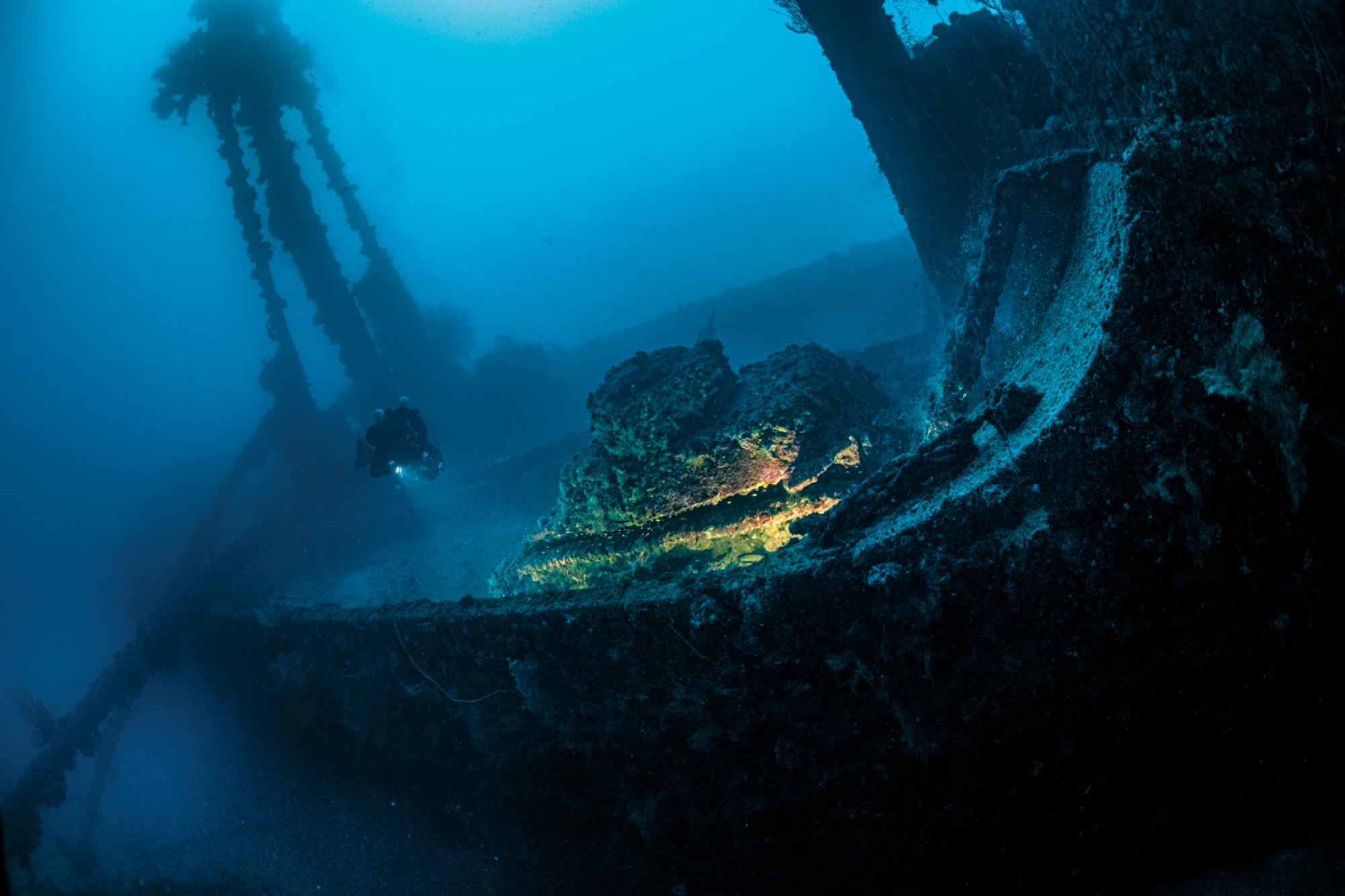Embracing the Deep in Chuuk Lagoon
Chuuk Lagoon did not appear to me as it does in pictures, a densely forested atoll of islands haloed in teal and indigo, sandbanks and beaches glowing pearlescent. It came to life instead in the dark, pinpricks of light sprinkled in a coalblack expanse of water and uninhabited land.
Often referred to as the wreck diving capital of the world, Chuuk Lagoon was popularized in the 1970s by Jacques Cousteau, who explored and filmed its ghostly World War II shipwrecks.
Wreck mecca though it is, the Federated States of Micronesia is one of the least visited countries in the world. It’s remote and takes time to get to, which also means it can be costly, keeping it off most recreational divers’ travel radar. For wreck aficionados, however, Chuuk Lagoon is not merely a destination to check off a dive bucket list. It’s a life event.
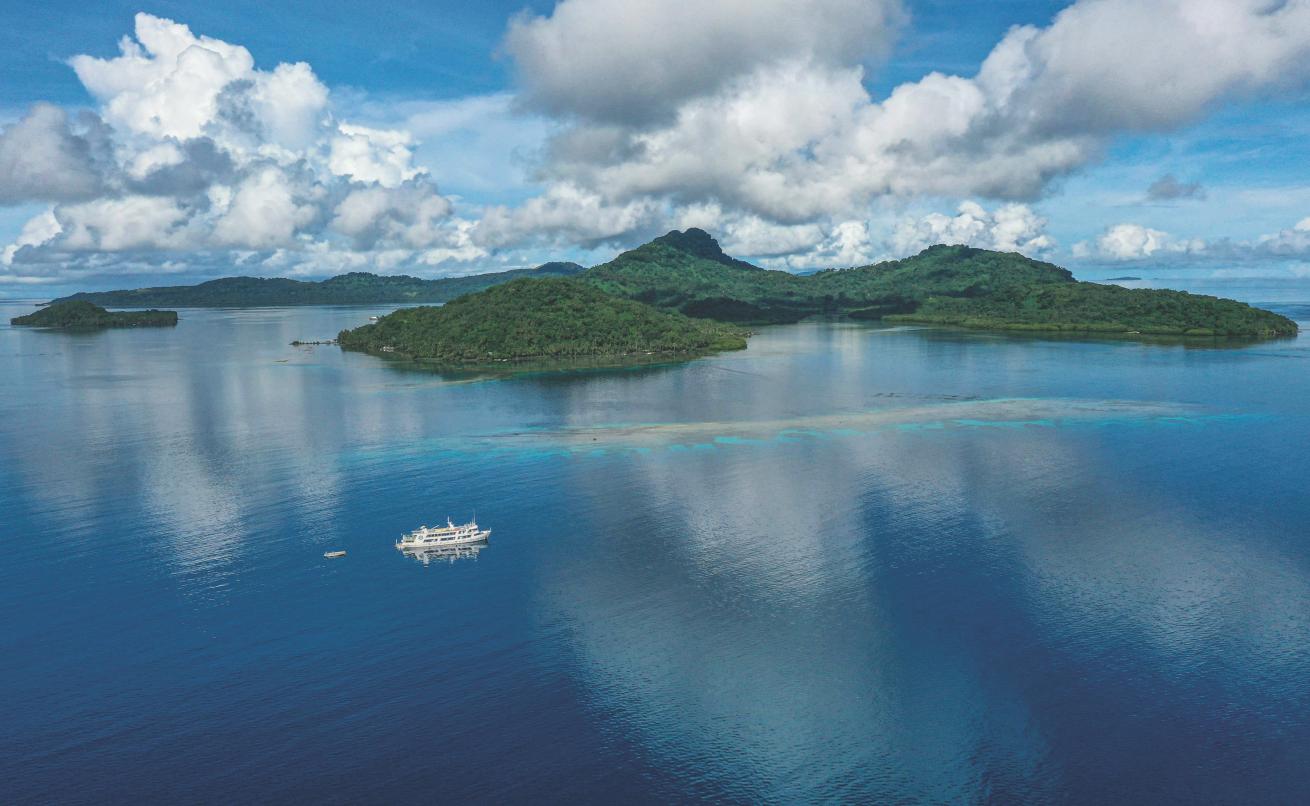
Brandi MuellerThe island of Tonoas—known as Dublon during World War II—rises behind M/V Odyssey on the mooring for the Nippo Maru wreck.
Waylaid by Typhoon Mawar and United Airlines’ own tangle of logistics, I arrived on the island of Weno in the early hours of the morning, a month later than originally planned, exhausted after 35 hours of flying time.
Odyssey Adventures met me at the airport and drove me to the dock. In the few minutes it took to get to the liveaboard, I snatched glimpses of Chuukese homes, some built from concrete, others from corrugated iron. Many included small familyplot graveyards. Tropical foliage grew so dense in all directions— creeping up against shops and homes, crawling over and into old vehicles—I couldn’t imagine not owning a machete if I lived here.
I felt a small pang of regret. Due to my late arrival, I would have to skip the sightseeing I’d originally planned—a museum at Blue Lagoon Dive Resort and a hike up Mount Tonnachau to see 6,000 year old Chuukese middens and Japanese fortifications erected in World War II.
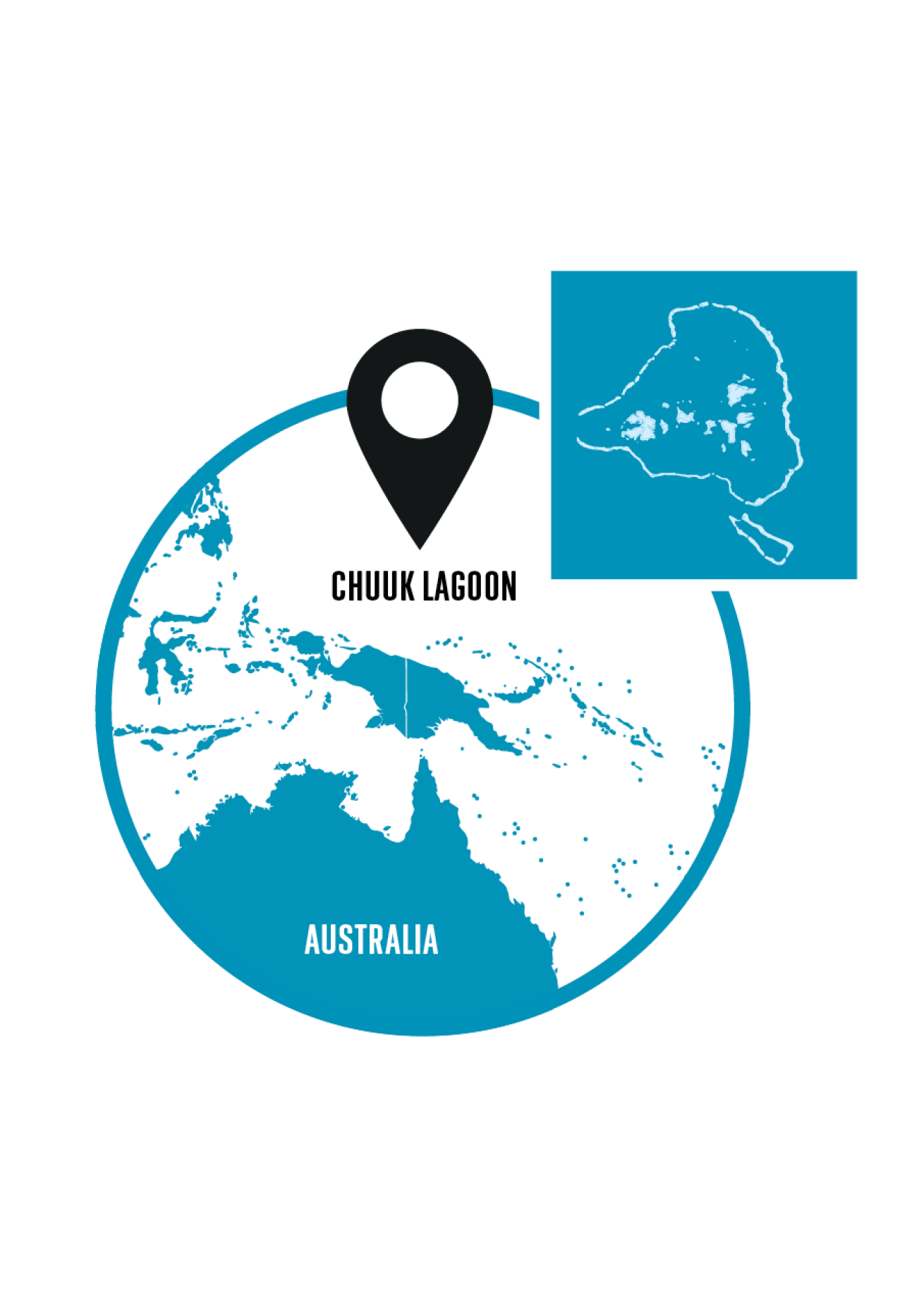
From Naval Fortress to Ship Graveyard
In February 1944, Chuuk Lagoon (then known as Truk Lagoon) was Japan’s main naval base in the South Pacific. Considered “the Gibraltar of the Pacific” by Allied forces, it was a major threat, and the U.S. Navy began making plans to destroy it in an aerial assault named Operation Hailstone. A week before the raid began, forewarned by intelligence, Japan withdrew many of its large warships.
The Japanese military either did not move fast enough or thought it had more time. By the morning of the attack, the atoll still harbored 50 merchant ships, 18 warships and 350 planes. Though Operation Hailstone lasted just three days, the outcome for Japan was tragic. Approximately 4,500 Japanese personnel perished—a toll nearly double the American losses at Pearl Harbor.
The attack also sank 45 Japanese vessels and numerous aircraft, plunging them into the depths of Chuuk Lagoon. This event marked the creation of what is now one of the most renowned ship graveyards in the world.
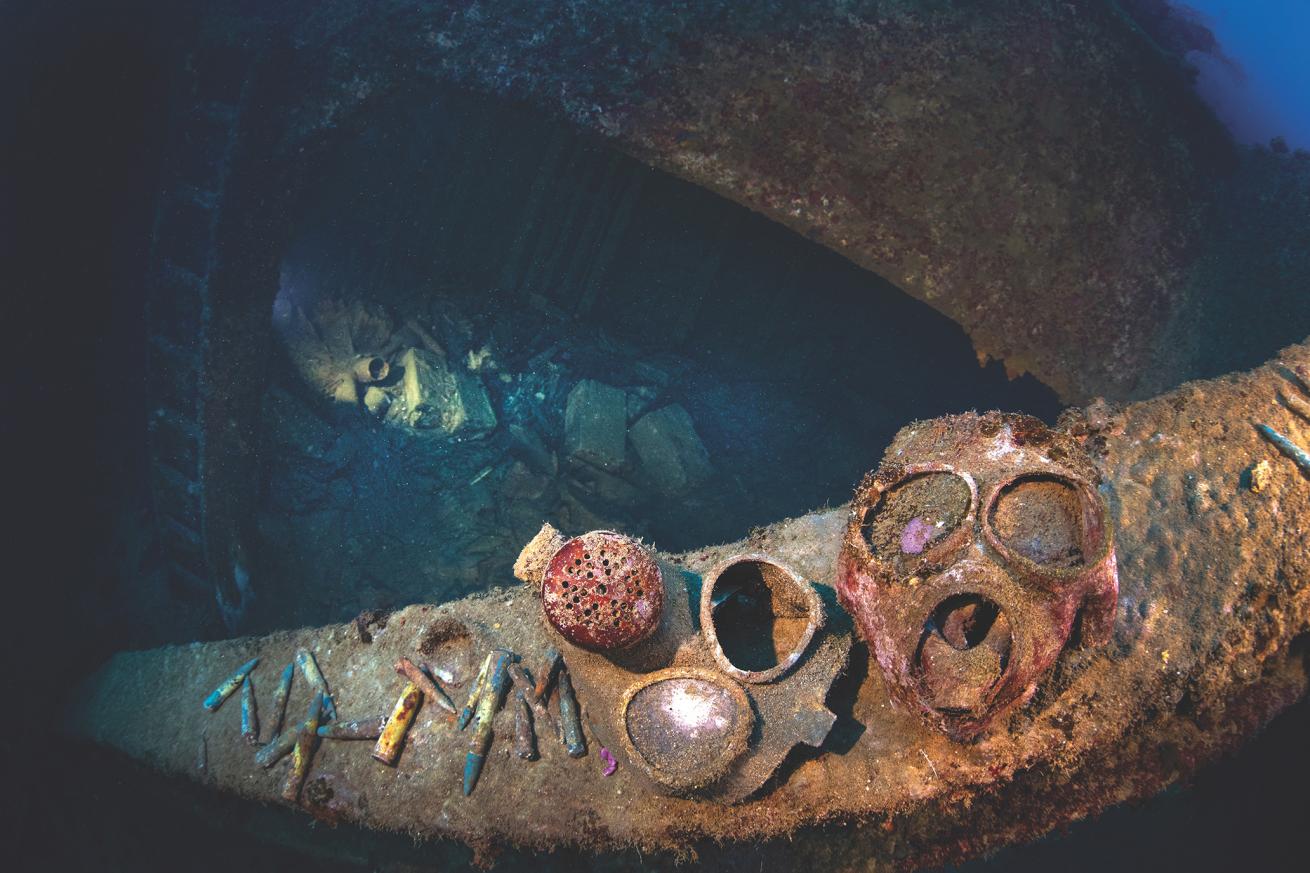
Becky Kagan SchottA gas mask overlooks a cargo hold on the Nippo Maru wreck.
OVER THE NEXT SIX DAYS WE WILL DIVE 15 WRECKS, SOME MORE THAN ONCE. THESE ARE WRECKS SO LARGE THEY BOGGLE THE MIND.
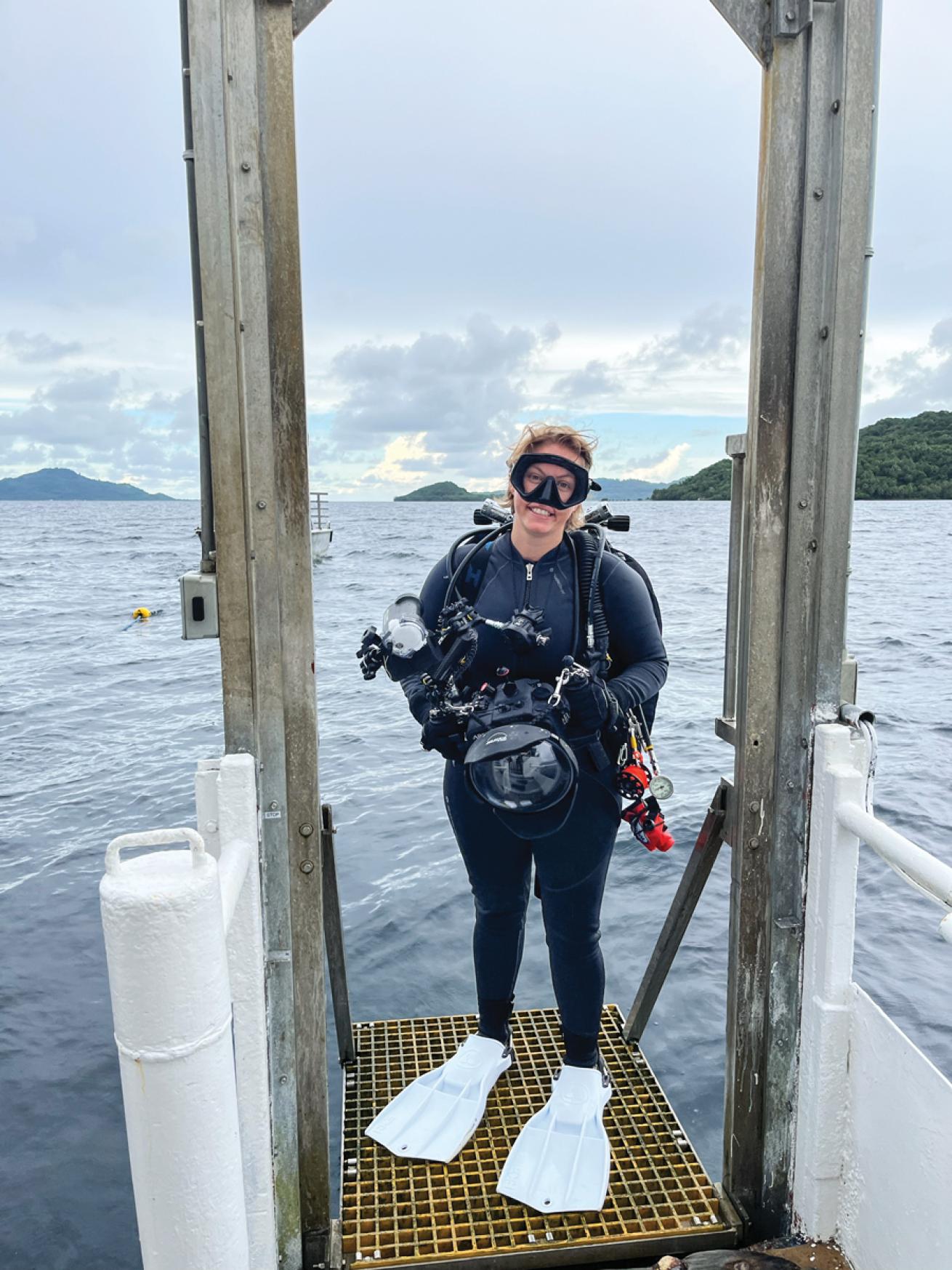
Brandi MuellerCandice on the dive elevator, a luxury for all divers on board.
Vessel With a View
Today, the Odyssey liveaboard makes a perfect staging ground for diving a few of the 60-plus World War II wrecks. The vessel is set up to cater to both recreational and technical divers. Four-seater tables in the dining room also add a level of intimacy that helps passengers quickly get to know one another, and a wellstocked bar presides over it all, keeping pace with even the most dedicated Sapporo drinkers.
Each morning I eat breakfast looking out over the calm water, the rugged islands and, sometimes, fog. Bunches of bananas sway on the deck, slowly ripening, and my Sharkskin, new exposure protection for me, dries faster than any wetsuit on board.
Over the next six days we will dive 15 wrecks, some more than once. These are wrecks so large they boggle the mind; we’re encouraged to take guides. Crew-to-passenger ratios are excellent—there are 13 of us and four guides. Each guide dons a set of doubles, providing an extra level of safety underwater.
Feel the Fear and Do It Anyway
After an orientation dive, we make our way to the cargo ship Yamagiri Maru. By the time I’ve entered the water, my always smiling dive guide Maddie is jetting into the depths. I can hear him singing through his regulator as he plummets, fins whirring behind him like a propeller.
Yamagiri Maru is as vast as a reef, over 400 feet in length, and rests on its port side, with a huge torpedo hole bitten into it. When we penetrate the wreck, my anxiety begins mounting. A ship on its side underwater is hard for the mind to understand, especially when 80 years of growth, oxidation and collapse have altered it beyond comprehension.
Related Reading: Delve Into Tec Diving on a Red Sea Vacation
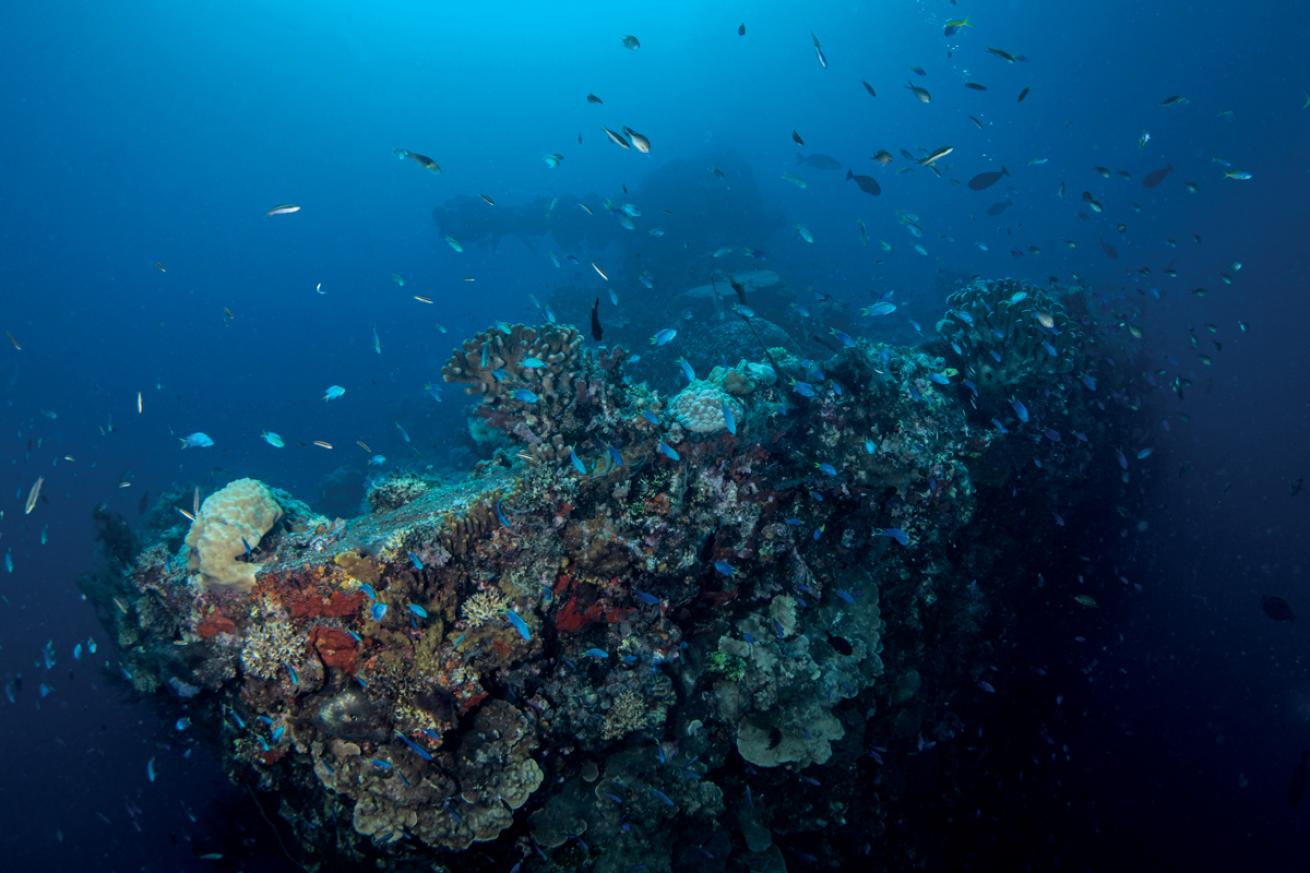
Candice LandauThe intact bow gun on Fujikawa Maru
People are sometimes surprised to learn I struggle with anxiety. “How is that possible?” they ask. “You travel on your own. You try so many scary things. How are you able to do that while still dealing with your fears and worries?” I’ve ruminated on these questions for some time and suspect there are a couple of reasons.
Growing up in South Africa, a country known for violent crime, I was often forced to quash my anxiety and just get on with things. You can’t worry about being hijacked or robbed every second of the day. The second reason is surprisingly rational. My parents owned a book titled Feel the Fear and Do It Anyway.
Over the years I’d pick it up and dip into it. Though I never read it cover to cover, it was a phrase that stuck with me. It normalized feeling fear (feel the fear) and it told me how to deal with it (do it anyway). Over time it became a mantra, helping me get through dive training, job interviews and everything in between.
As we venture inside Yamagiri, I allow my anxiety its place and focus instead on the beauty. Maddie swims through tall beams that once served as floor supports for the cargo hatch. Schools of fish drift back and forth in the gentle current.
Whip corals and sponges and tube worms and small shrimp adorn the beams, and light dances over it all. In the distance, Maddie’s singing continues, a serene soundtrack to our underwater exploration.
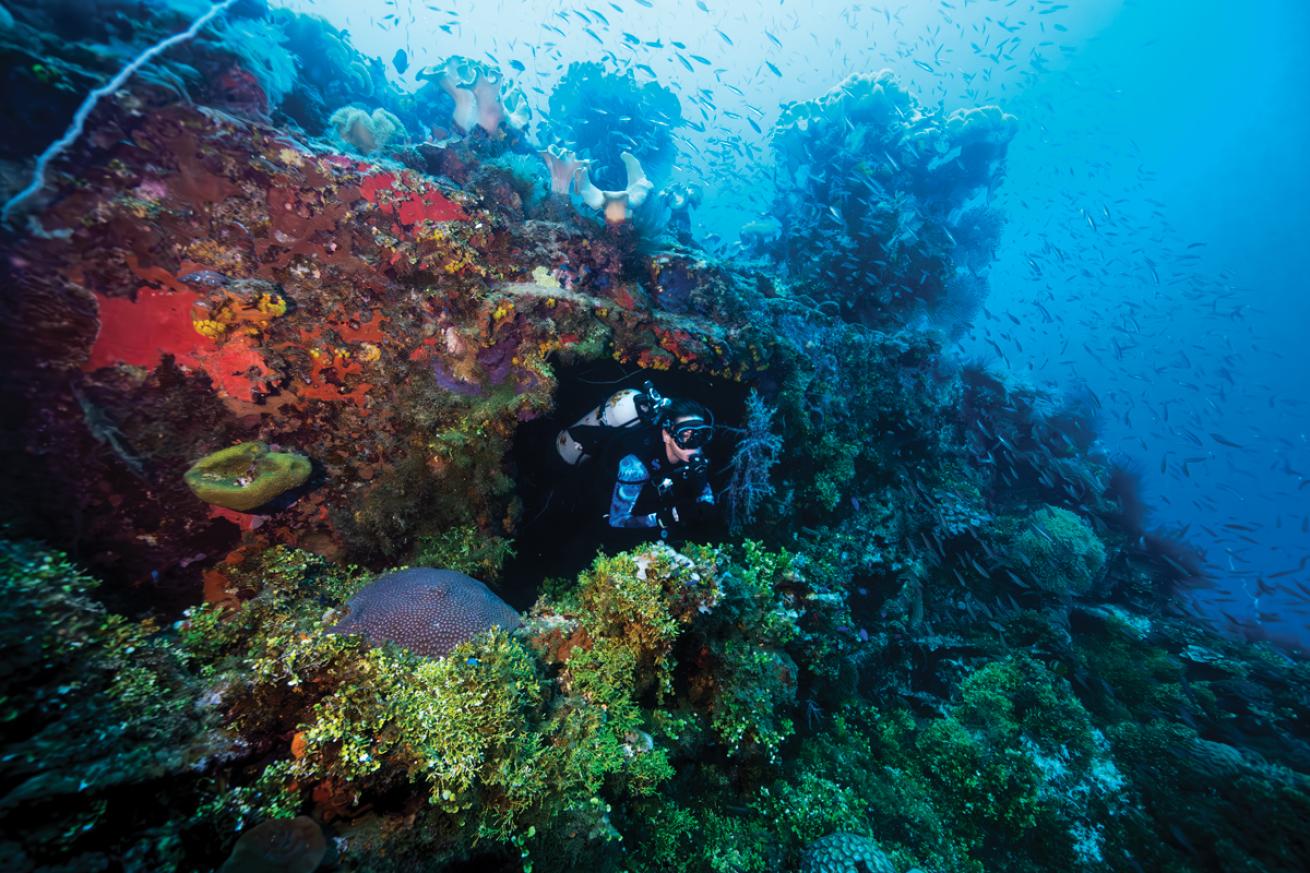
Brandi MuellerHeidi Ingram swims out of Fujikawa Maru
Sites Dived on This Trip
Many of the ships in Chuuk Lagoon have the word Maru appended to them. Though maru means circle in Japanese, in the context of ship names, it is not a literal interpretation. Rather it is symbolic and historical and was a name dedicated to any merchant or passenger vessel in the Japanese fleet.
» Kiyosumi Maru
» Yamagiri Maru
» Fumizuki destroyer
» Shinkoku Maru
» I-169, Kaidai-class submarine
» Betty bomber
» Fujikawa Maru
» Nippo Maru
» Heian Maru
» Hoki Maru
» Pizion Reef
» Sankisan Maru
» Seiko Maru
» San Francisco Maru
» Kensho Maru
After Yamigiri we dive the Fumizuki destroyer and then the I-169, a Kaidai-type submarine. It’s an impenetrable cigar, and though it makes me think of the riveting true story of U-869 from Robert Kurson’s book Shadow Divers, it somehow doesn’t have the gravitas that a hulking wreck like Shinkoku Maru does, open holds and holes beckoning curious divers inside.
Shinkoku is a favorite dive for many. At 500 feet in length, the sunken tanker offers endless possibilities for exploration. Inside its superstructure the past is tangible. Brown and blue glass medicine bottles litter the floor of the sick bay and operating room, and white-tiled Japanese bathtubs and toilets appear from beneath years of silt.
Confident in my abilities and the calm I seem to be projecting, Maddie heads for the engine room. As he twists and turns through Shinkoku’s insides, navigating stairwells and tight turns without guide lines or a map, I find myself tensing up again, anxiety increasing as we get farther from ambient light.
Related Reading: The Importance of Learning a Wreck's History
DIVING, FOR ME, ISN’T JUST A PURSUIT OF TRANQUILITY FOUND IN THE MARINE WORLD; IT’S EQUALLY A JOURNEY INWARD, A CONFRONTATION WITH THE RECESSES OF MY OWN PSYCHE.
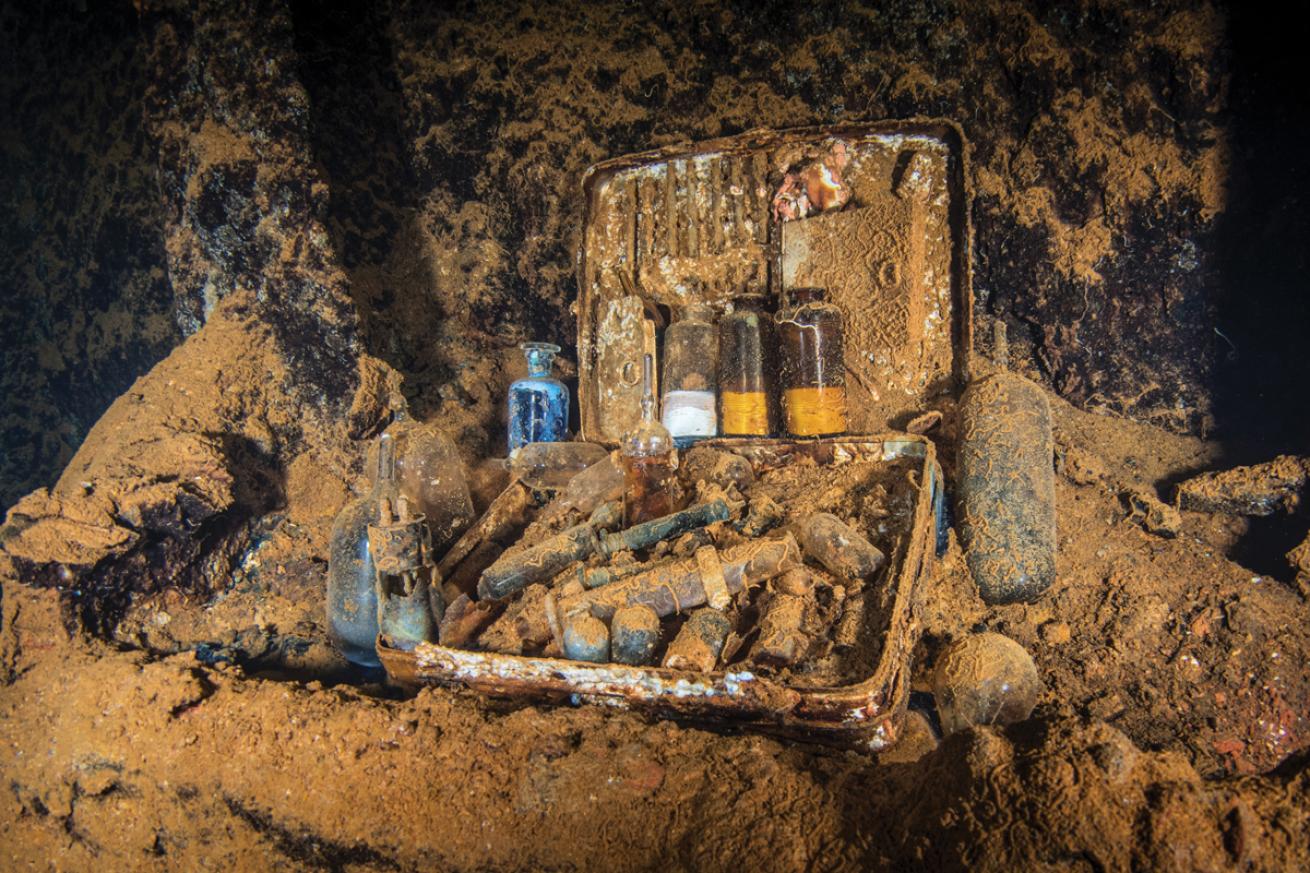
Candice LandauA medical kit lies open on Heian Maru, medicine bottles and other medical equipment on display
My heart takes center stage, beating heavily against my chest, a metallic coil of fear my constant company. I focus once more on the things that surround me—rubber shoe soles, china, gas masks—eerie artifacts of war that oddly keep me calm.
It isn’t long before sunlight takes the final edge off. Maddie croons over an anemonefish and I take a moment of my own. Gazing back into the shadowy depths of the wreck, I find myself pondering the paradox of my feelings: the oscillation between unease and a deep affection for these confined spaces.
Diving, for me, isn’t just a pursuit of tranquility found in the marine world; it’s equally a journey inward, a confrontation with the recesses of my own psyche. Each dive is a training ground, a place where I learn to quell ancient instincts of flight. It’s in these depths that I challenge myself, tempering fear with fascination.
This is not just a hobby; it’s a test of will, a challenge I wouldn’t forgo for anything.
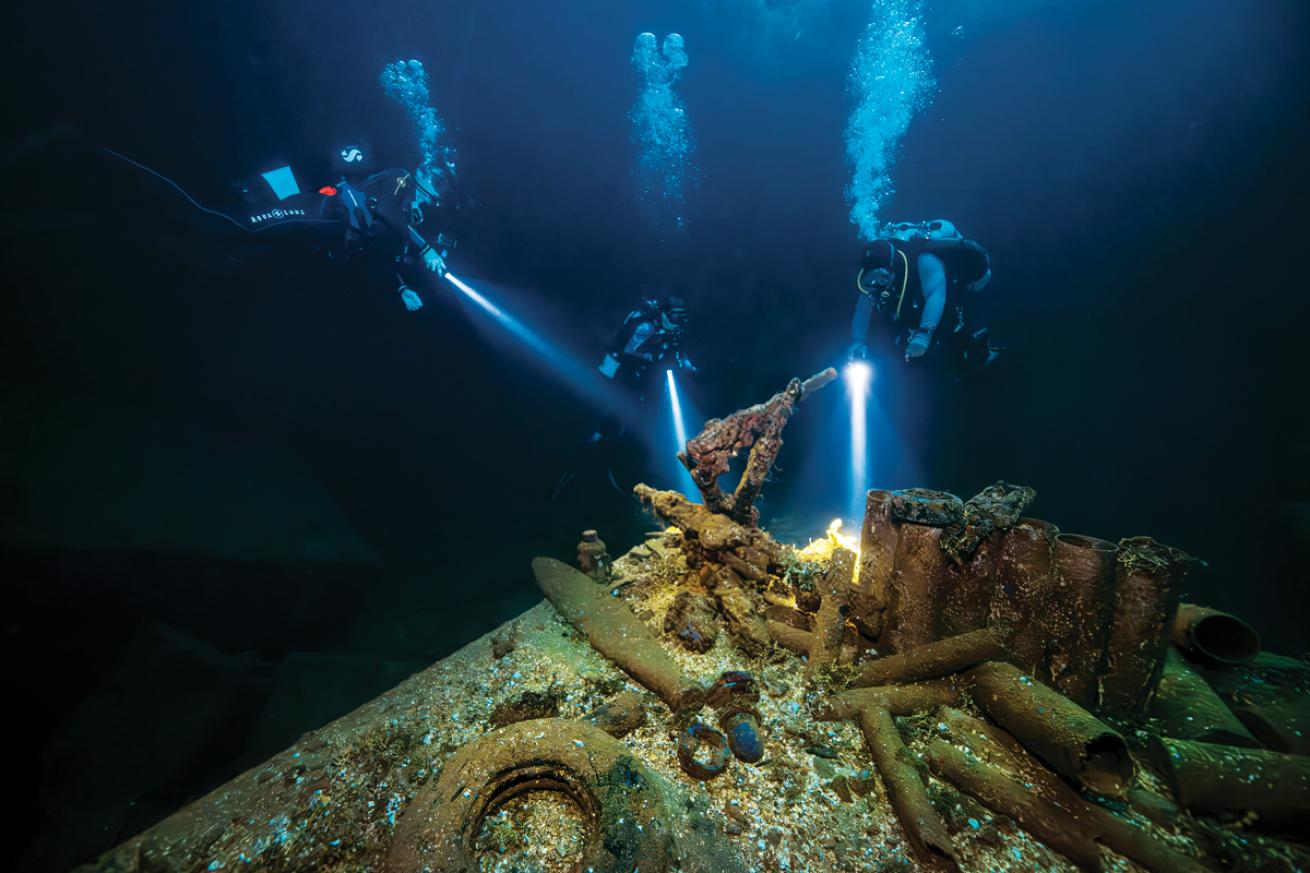
Candice LandauKyle, Heidi and Kichacy inspect artifacts of war inside the hold of Fujikawa Maru.
The Comfort of Training
Of all the wrecks in Chuuk Lagoon, the Heian Maru proves most memorable, a 510-foot leviathan too large to see in a single dive. Once a passenger liner, Heian Maru was outfitted for war and converted by the Japanese into a submarine tender. The ship’s name is clearly visible from the outside, originally scraped clean of algae and coral by Jacques Cousteau’s own crew over 50 years ago.
Lying on its port side, the wreck is only 115 feet deep, with much of the surface-facing starboard side covered with mound and star coral, ear-like brown algae and a rich patina of encrusting coral that looks like gold military camouflage.
Kichacy is my guide on this wreck, a quieter man who knows these ships just as well as Maddie. I’ve teamed up with him and two others: Kyle Ingram and his wife, Heidi. Kyle is the regional manager of Hawaii and the Pacific at PADI. Though we had no notion we’d be on the same trip before setting out, it’s a pleasant surprise and a novel way to get to know a colleague.
When Kichacy guides us inside, I gesture them ahead of me, preferring to be last in line so I can look back from time to time, an attempt to understand how the wreck might appear if I have to turn around in an emergency.
ANXIETY TAKES SECOND STAGE TO FOCUSING ON MY DIVING TECHNIQUE, TAILORED FOR DEMANDING ENVIRONMENTS LIKE THIS.
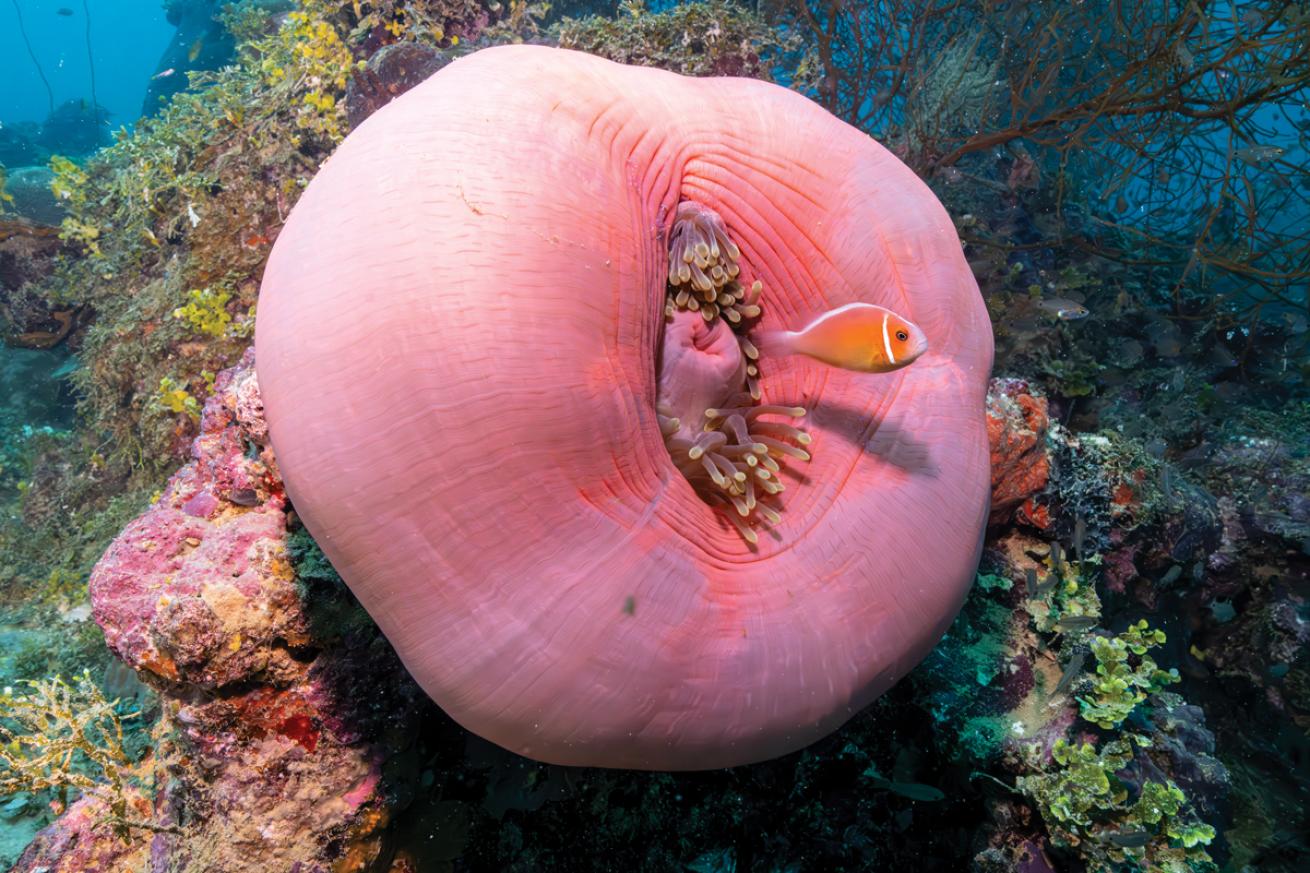
Candice LandauAnemones frequently adorn the wrecks of Chuuk Lagoon.
The passages here are perhaps the tightest and most labyrinthine of all the wrecks we dive, so much so that anxiety takes second stage to focusing on my diving technique, tailored for demanding environments like this. I take comfort in the fact that I’ve done some cave and technical diving.
Not a requirement for diving Chuuk Lagoon by any means, my training has still given me skills and experience that equip me to dive without stirring up silt, to streamline my equipment and to know how to deal with issues should they arise in an enclosed environment where we move in single file. I keep my hoses tucked in tight and I fin barely enough to get propulsion, pivoting and twisting through bars, ducking below hanging lines and passing through shafts.
This dive transcends a mere underwater excursion; it’s akin to a cave dive, demanding precision, caution and an acute sense of self. Every heartbeat, every controlled movement through the wreck, reinforces my respect for this underwater world and the profound lessons it imparts about the importance of continuing education.
Related Reading: Dive Hotspots: Truk Lagoon, North Carolina and Vanuatu
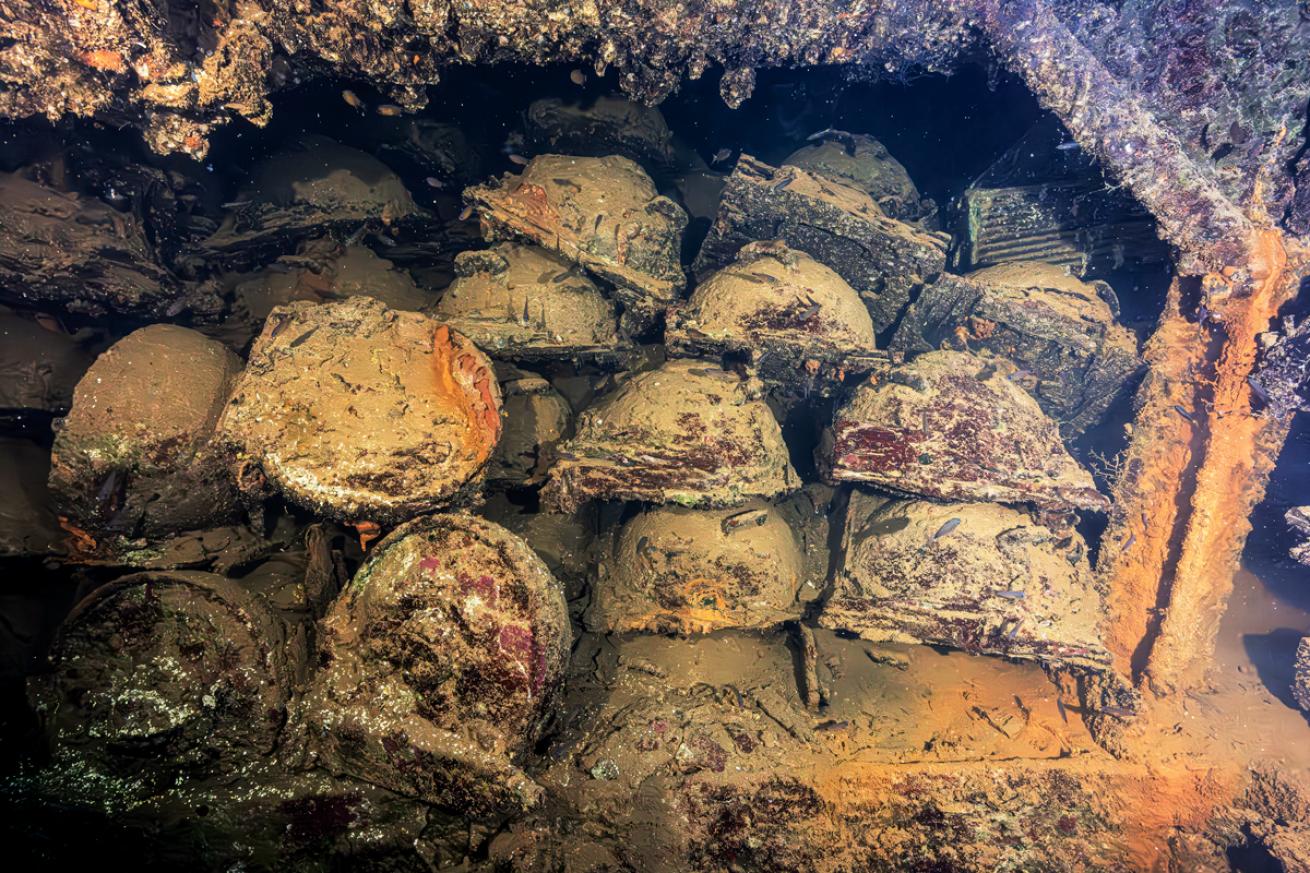
Candice LandauLand mines stacked inside a hold on the San Francisco Maru
Plan for Peace
On the penultimate day aboard, the crew asks if I’ll be diving the San Francisco Maru and whether I’ll need a deco bottle. It’s one dive they don’t assume we’ll all make, and indeed, five passengers sit it out.
San Francisco Maru, often known as the Million Dollar Wreck due to the estimated value of its cargo, is the iconic wreck dive in Chuuk Lagoon. It’s also a dive that requires decompression. Though not as large as some of the others, this steamship is deep and sits upright in 210 feet of water. The main deck starts at 160.
While we won’t be spending long on the San Francisco, due to its depth—just 15 minutes of bottom time—I feel the need to calculate both my gas and my decompression plan. The crew will stage deco bottles on the mooring line, but I’ll carry my own too.
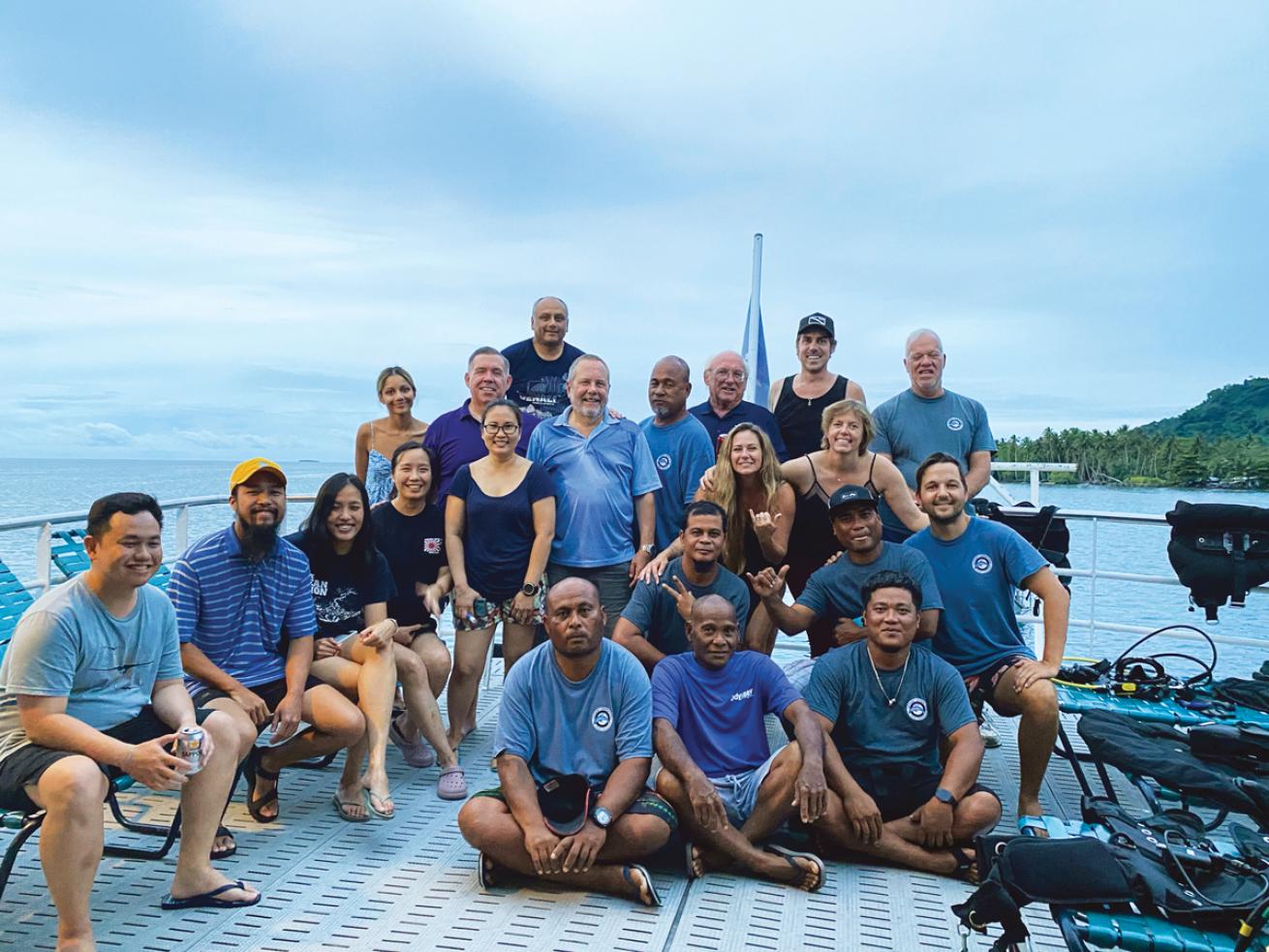
Candice LandauThe author, fellow passengers and crew pose for a photo on the last day at sea
This level of planning is more than a procedural necessity; it’s my pathway to relaxation underwater. The assurance that every detail has been considered and every contingency accounted for allows me to transform potential anxiety into calm focus.
As my buddy Rich lightheartedly reminds me to relax, I realize my relaxation is rooted in this very planning. The thoroughness of my dive plan is not just about ensuring safety; it’s about creating a space where I can truly immerse myself in the experience, free from worry or haste.
The planning pays off. At 180 feet I feel calm. I fin slowly through Hold 1 and 2, examining mines and bombs teetering one on top of another. A vehicle, precariously balanced on the tween decks, etches a vivid picture of a bygone era, transporting me momentarily into a different time.
On the main deck, Rich, Kichacy and I linger at the bow gun and then again at two tanks covered with life. As I pause to take photos I think about the transient nature of our presence down here.
It is with a feeling of both fulfillment and reluctance that I begin my ascent, a methodical but gradual reconnection with the surface world. Back on board I share a smile with Rich and Kichacy, an unspoken acknowledgment of the extraordinary experience we’ve shared.
The San Francisco Maru, a dive demanding respect and caution, has offered more than just an exploration of its historic treasures; it has provided a deeper appreciation for the delicate balance between adventure and mindfulness in diving.
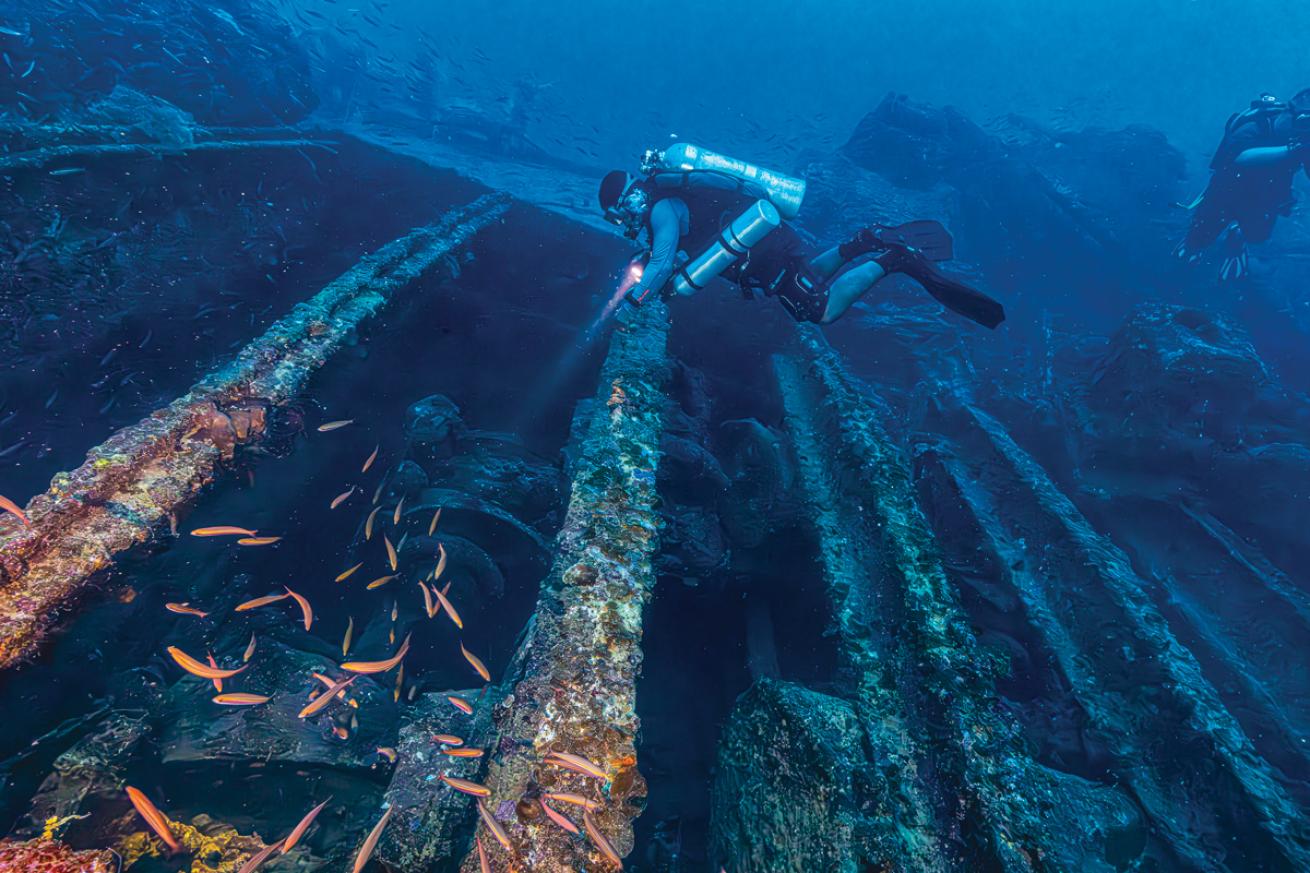
Candice LandauDive guide Kichacy on the* San Francisco Maru*.
Need to Know
Conditions
Water temps in this region range from 82 to 84 degrees Fahrenheit. Visibility can range from 30 to 100 feet, depending on weather and where in the lagoon you’re diving. There is very little current.
When to Visit
Chuuk Lagoon is divable yearround, but conditions are best from December through April in the drier months. What to Wear Depending on how sensitive to cold they are, divers choose everything from rash guards to 5 mm wetsuits.
Travel Tips
In case of flight delays, it’s recommended you arrive at Chuuk International Airport a couple of days in advance. Airport transfers to both Blue Lagoon Dive Resort and Truk Stop Hotel are included.
Recommended Certifications
PADI Advanced Open Water Diver, Enriched Air (Nitrox) Diver, Wreck Diver and Deep Diver. Tec 40 and other more advanced technical diving certifications are useful for divers who want to do longer, deeper dives.
Fees
Fees for diving start at $3,495 per person for double occupancy in 2023, increasing slightly in subsequent years. This fee does not include a 5 percent sales tax, a $50 dive permit fee, or the Chuuk departure tax of $30. Bring cash for tips. Nondivers receive a 10 percent discount. Nitrox is provided at no additional charge.
Operator
Odyssey Adventures (trukodyssey.com). This trip was done in June 2023.

